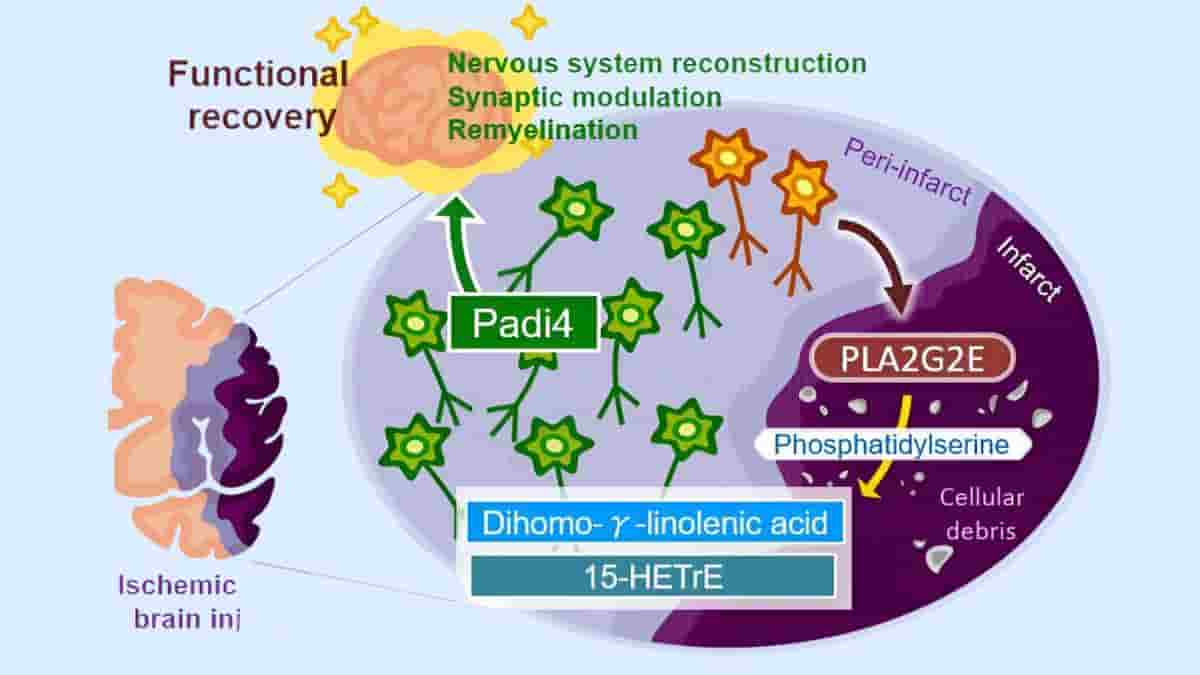Patients frequently experience functional decline following an ischemic stroke, owing to the brain’s resistance to regeneration after damage. However, there is still hope for recovery because surviving neurons can activate repair mechanisms to limit and even reverse the stroke’s damage.
But how is it triggered?
Tokyo Medical and Dental University (TMDU) researchers have provided new insights into this question by identifying a new mechanism. They discovered that neurons near the site of cell death secrete lipids that can stimulate brain-autonomous neural repair following ischemic brain injury.
“There is evidence that more lipids are produced after tissue injuries and contribute to regulating inflammation. We investigated the changes in lipid metabolite production in mice after ischemic stroke. Interestingly, the levels of a specific fatty acid called dihomo-γ-linolenic acid (DGLA) and its derivatives increased after the stroke,”
said senior author Takashi Shichita.
Ischemic Stroke Self-repair
An ischemic stroke occurs when the blood supply to the brain is cut off, causing brain cells to die. Brain inflammation contributes to the ischemic stroke effects.
There are four major mechanisms of ischemia in the brain:
- obstruction of a blood vessel by a blood clot forming locally
- obstruction due to an embolus from elsewhere in the body
- general decrease in blood supply, such as general shock
- presence of a blood clot in the dural venous sinuses (which drain blood from the brain), the cerebral veins, or both
The condition is potentially fatal, and patients will most likely develop functional disabilities. Although the adult brain can self-repair, the underlying mechanisms remain unknown.
The researchers discovered that DGLA increase is mediated by a protein known as PLA2GE2 (Phospholipase A2 Group IIE, an enzyme). By manipulating its expression, they demonstrated the impact of PLA2GE2 expression on functional recovery.
PADI4 and PLA2GE2
PLA2GE2 deficiency resulted in increased inflammation, decreased expression of factors stimulating neuronal repair, and increased tissue loss.
The team continued to identify the PLA2GE2/DGLA targets. They discovered low levels of a protein called peptidyl arginine deiminase 4 (PADI4) when they examined genes expressed in mice lacking PLA2GE2.
“PADI4 regulates transcription and inflammation. Remarkably, expressing PADI4 in mice limited the extent of tissue damage and inflammation after ischemic stroke,”
explained Akari Nakamura, lead author of the study.
Furthermore, the research indicates that PADI4 promotes gene transcription in brain repair. It also pinpoints the entire signalling pathway that is involved in this process.
DGLA Blood Levels
The majority of the data came from an ischemic stroke mouse model. However, the researchers discovered that neurons surrounding the stroke site express PLA2G2E and PADI4 in humans, indicating that the recovery pathway exists.
Furthermore, another recent study found that lower serum DGLA levels were associated with severe ischemic stroke and human cognitive disorders.
This study describes a new mechanism that initiates brain repair following an ischemic stroke, which could lead to the development of compounds that promote PADI4’s effects and thus stimulate patient recovery.
It may also alter our current understanding and approach to Eicosapentaenoic acid (EPA) and Docosahexaenoic acid (DHA) as the only beneficial lipids for preventing atherosclerosis and vascular disease.
Reference:
- Nakamura, A., Sakai, S., Taketomi, Y., Tsuyama, J., Miki, Y., Hara, Y., Arai, N., Sugiura, Y., Kawaji, H., Murakami, M., & Shichita, T. (2023). PLA2G2E-mediated lipid metabolism triggers brain-autonomous neural repair after ischemic stroke. Neuron, S0896-6273(23)00483-X
